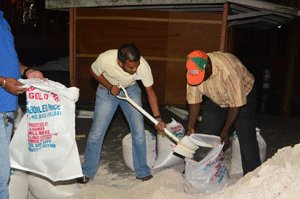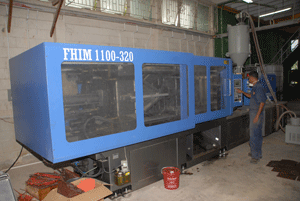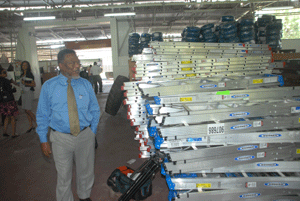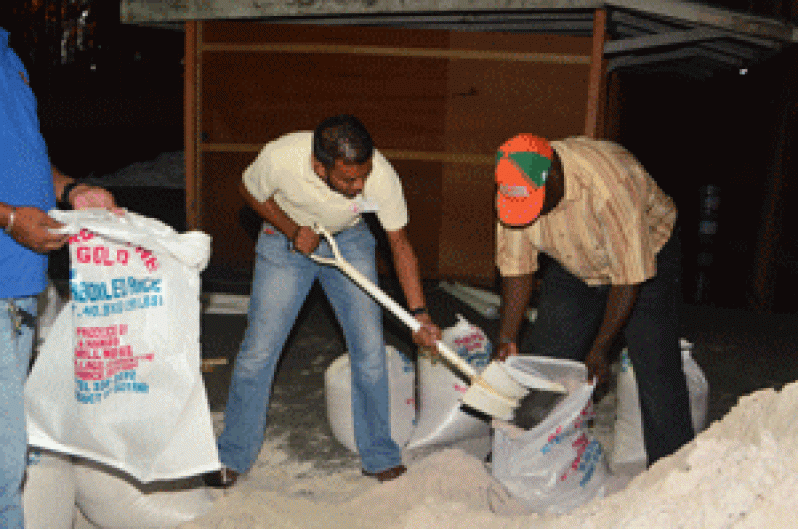THE Institute of Applied Science and Technology (IAST) will unveil ground-breaking technology for alternative building materials and fuel at the Guyana International Building Expo which opens at the National Stadium at Providence, East Bank Demerara, today.  The centerpiece of the IAST display will be roof shingles made out of recycled fibers of rice husk, waste wood shavings , bagasse and recycled plastics .
The centerpiece of the IAST display will be roof shingles made out of recycled fibers of rice husk, waste wood shavings , bagasse and recycled plastics .
On display too will be a hydraulic briquette machine which can convert rice mill and saw mill waste into pellets for use as efficient sources of fuel for both domestic and industrial purposes.
The two items were described as exciting technology for the use of waste materials and were discussed yesterday by Director of the IAST, Dr. Suresh Narine, during a visit by the Chronicle to the IAST headquarters at the University of Guyana’s Turkeyen Campus yesterday.
The flat rectangular shingles are being made at the IAST’s laboratories, using equipment described as an injection mold.
“This plastic shingle addresses both the boom in the housing industry as well as recycling of certain forms of waste,” Dr. Narine said.
In the manufacture of the plastic shingles, the rice husk and other waste is mixed with plastics ( either recycled or virgin plastics) , fed into the mold and emerges at the end of the process as excellent  materials for roofing of homes.
materials for roofing of homes.
“When we say excellent materials for roofing, we are not exaggerating; they are not only good looking but tough” Dr. Narine said.
“Unless you physically break one of these shingles, they will last a lifetime on your roof.”
“And by lifetime, I mean at least 60 years,” he said, adding that IAST will add UV protection and anti bacterial material to make the plastic shingles even stronger.
He disclosed that this kind of roofing , which will be made in several colours, is sought by high income property owners; but with the injection molding technology , low income property owners will soon benefit as well.
The hydraulic briquette machine , which he called a mini gasifier, tackles the problem of rice mill and sawmill waste by converting it into pellets which can be used as a clean source of fuel.
“The problem with wood waste and rice husk waste is that they don’t burn; they just burn out; so we have this technology to make pellets with the rice mill and saw mill waste. The pellets burn just like firewood. We also have a stove designed to utilize these pellets,” he said.
He said that when IAST decides to go commercial with the pellets, they will tell buyers the amount of time the pellets will take to burn out and the heat they will give before burning out. “The stove that will be using the pellets is designed to be as efficient and as convenient as a gas stove,”he said.
“The stove that will be using the pellets is designed to be as efficient and as convenient as a gas stove,”he said.
Speaking on the future development of the plastic roof shingles, Dr. Narine said that IAST had done years of research into the injection molding process before deciding to get into it as a means of constructing shingles.
The IAST had also exhaustively tested the shingles for durability before deciding to unveil the new product as a pilot scheme.
He disclosed that IAST has been approached by two businessmen who would like to partner with the institute in the commercial production of the shingles but no arrangement has been concretised as yet.
He said that IAST proposes to spend some time on introducing the technology to the market.
This will include placing the shingles on prominent new buildings and a programme of advertising so that people can see them and see their usefulness as alternative roofing materials.
The injection mold at the IAST can manufacture 40 shingles in an hour.
“We can take about a year to market it, then we will interest a commercial partner to invest in larger scale equipment ,.” He said.
He added though that to ensure the quality is kept at a high level and that any scientific issues that arise are dealt with, IAST would like to pilot the shingles as a pre-commercial opportunity for some time into the future, before handing it over fully to a commercial partner.
With respect to the briquette machine, after the Expo, IAST will mount the machine on the back of a truck and then drive over to the rice mills and sawmills and collect their waste to make the briquettes “In Guyana, we make 110,000 tons of sawdust and hundreds of thousands of rice husk annually. This is one very elegant way of addressing the issues (of wast disposal) while at the same time providing a very seamless source of fuel for domestic as well as industrial use,” he stressed.
“In Guyana, we make 110,000 tons of sawdust and hundreds of thousands of rice husk annually. This is one very elegant way of addressing the issues (of wast disposal) while at the same time providing a very seamless source of fuel for domestic as well as industrial use,” he stressed.
He pointed out that two rice mills have been shut down recently because of environmental pollution issues, so he is very optimistic that the technology will be seen as useful as fuel for the mills, since it will be fuel in a more accessible format.
He said that the next step in the use of briquette technology is a full economic analysis of where the waste material is located, how much money will be spent on making the pellets, and how much they will cost the consumer.
Dr. Narine added that the injection mold will subsequently be used not only for manufacture of roof shingles, but for other products, such as plastic parts for vehicle and ceiling tiles.
The shingle making mold will subsequently be used to produce a wider variety of plastic products, so that IAST can utilize bio mass to make much stronger much more durable, and obviously much more inexpensive products.
“All that we have to do is make the molld and we can make it. The advantage we have is that we are using our materials with it.”
The Third International Building Expo opens today under the theme:”Embracing standards-Building the future” and runs until Sunday next.
IAST unveils new technology for building materials, fuel – … at Guyana International Building Expo
SHARE THIS ARTICLE :
Facebook
Twitter
WhatsApp



.jpg)








